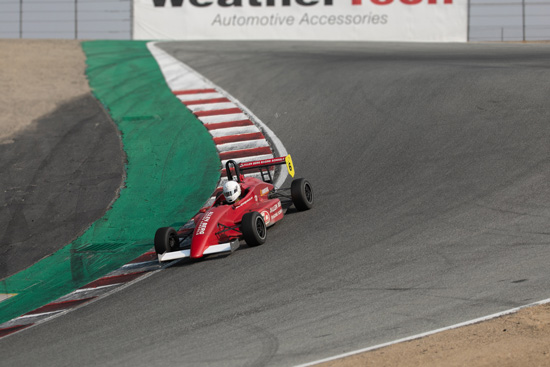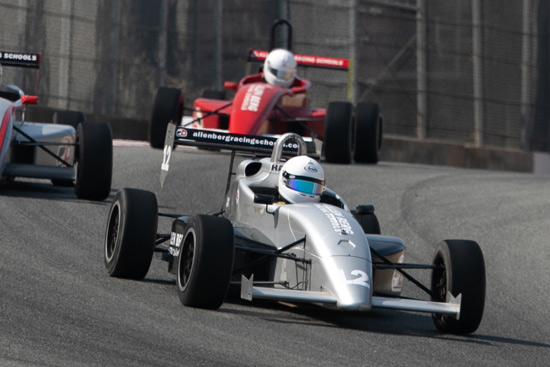Laguna Seca
“This is going to be expensive.” That was the first thought that went through my mind after I came to a stop.
I had just crashed a formula car in the iconic Corkscrew turn at Laguna Seca, and the car I was driving wasn’t mine.

Me driving down the Corkscrew, before the incident
Sean and I had been at that iconic Northern California track for the previous couple of days doing one of the racing schools there. It was an arrive-and-drive program: we simply showed up with our driving gear, and they furnished the cars.
Our machines were Formula Renault 1600s made by Tatuus, with 1.6 L inline-4 engines, sequential manual gearboxes, and carbon fiber tubs. Wings (sort of) and slicks, too. They were faster than my Formula Vee that Sean had borrowed for his first track experience a few weeks earlier, but slower than my F1000.
Despite the unusually hot and humid October weather, we took advantage of every millisecond behind the wheel that the school program offered. So enthusiastic was Sean that he was the first driver of the weekend to run afoul of Laguna’s infamously strict noise limits.
We got to know the cars better, and we became increasingly comfortable pushing them through the turns.
Like the Corkscrew.

Sean (silver car in foreground) is ahead of me (red car in background) at Turn 6. Or, from my perspective, I was waiting to pass him. (That is a completely accurate description of the situation, right Sean?)
The Corkscrew is unquestionably the most famous corner at Laguna and easily in contention for being the most famous among all corners at all race circuits in the world. It’s a sharp blind left-hander that transitions into a moderately fast right-hand turn at its exit. That would be pretty ordinary, but what sets it apart is the elevation change from entry to exit: a loss of 60 vertical feet at an incredible grade of about -15%. Purists might scoff that turns 2, 9, and 11 are tougher to execute optimally, but that takes nothing away from the Corkscrew itself.

Sean driving his F150 down the Corkscrew during the track tour
Near the end of the last track session of the last day of the school, I decided to get a bit more aggressive in the Corkscrew. Unfortunately, I lined up on the wrong visual reference tree for the turn-in.
The ground fell away, like normal, causing the car to get light — also like normal — but the slightly sub-optimal line led to a harder “landing” than usual. Nothing would have come of it but for a bolt in the front suspension that had been invisibly edging towards fatigue failure. The hard landing exceeded the strength of the remaining cross-sectional area in that bolt, the bolt sheared, and the front-left suspension collapsed. The now-unrestrained front-left pushrod punched upward and sent the shock cover flying.
Surprised but running on instinct, I kept it pointed straight and brought the car to a controlled stop just off the track surface. That gave me some time to sit there worrying about what I’d done to the car.
Fortunately, once the car got back to the paddock, the hallmarks of fatigue failure (beachmarks, light corrosion in a thread root, and a large fast-fracture zone) were clearly visible on the portion of the bolt that had stayed with the car. Would it have given way without my slight excursion beyond track limits? Hard to say. On the other hand, the race school owner was apologetic about the bolt being degraded in the first place.
Without either of us losing too much face, and with no real damage to the car other than perhaps the fiberglass shock cover, we came to an amicable agreement that everything was fine and engaged in a pleasant chat about racing.
Recent Comments